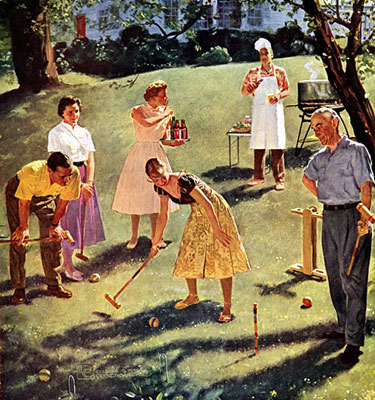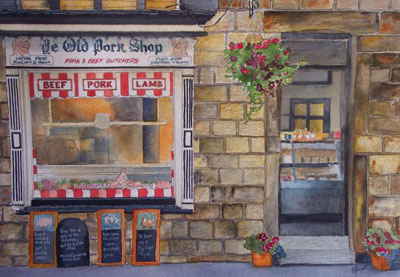 This is a story about Beef Stroganoff. But before your mind wanders to sour cream and Russian Tzars, picture the small kitchen in which it was created. Probably 9 by 9, with a rudimentary stove, a wooden counter which doubled as a chopping board, a hatch leading into a dining room, a single sink with a window facing onto the mountain, with the silver birch trees, where the blueberries and wild strawberries grew in the summer. The larder, where on special occasions gravlaks was made (weighed down with wooden boards and round lead sinkers), was reached via a trap door in the wooden floor, the entrance covered by a red and white rag rug.
This is a story about Beef Stroganoff. But before your mind wanders to sour cream and Russian Tzars, picture the small kitchen in which it was created. Probably 9 by 9, with a rudimentary stove, a wooden counter which doubled as a chopping board, a hatch leading into a dining room, a single sink with a window facing onto the mountain, with the silver birch trees, where the blueberries and wild strawberries grew in the summer. The larder, where on special occasions gravlaks was made (weighed down with wooden boards and round lead sinkers), was reached via a trap door in the wooden floor, the entrance covered by a red and white rag rug.
Because this story takes place a long time ago, when I was just a small child, the details of the preparation of the stroganoff are hazy. In those days such things did not interest me, and although no doubt many conversations were had by the grown-ups in the family about which butcher had the best meat as it was a special occasion -- and just on that day money didn't seem to matter quite as much -- I think I may have been sitting on the roof of the wooden outhouse, picking black morello cherries and stuffing them into my mouth at the time.
I did know that when the meat did arrive -- via my grandfather's dark red Lancia with its sweet-smelling leather seats -- there was a great welcoming party consisting of my grandmother, my mother, my aunt, maybe even my father in his rolled up jeans and a fish bucket, having coincidentally just stepped off the boat after a morning of catching cod and mackerel in the days when cod were as bountiful as the little crabs under the jetty. My grandfather was in his city clothes, his doctor clothes. The dark grey wool trousers, the pale blue shirt, the elaborately polished brown loafers he wore in Oslo. He carried the special stroganoff beef in front of him, laying it on his two hands like a tray, wrapped in white butcher paper and tied with twine. He had a smile on his face.

 Last year, we had friends and family over to celebrate La Vigilia, which is a traditional Christmas Eve feast that had its beginnings in the south of Italy. It celebrates the wait for the birth of baby Jesus. Vigilia – the wait. Traditionally the meal is comprised of seven fish dishes – including shellfish, of course – and it can be one of the great feasts of the year. It can be a blowout, actually, un cenone, which means a very large and very long dinner.
Last year, we had friends and family over to celebrate La Vigilia, which is a traditional Christmas Eve feast that had its beginnings in the south of Italy. It celebrates the wait for the birth of baby Jesus. Vigilia – the wait. Traditionally the meal is comprised of seven fish dishes – including shellfish, of course – and it can be one of the great feasts of the year. It can be a blowout, actually, un cenone, which means a very large and very long dinner.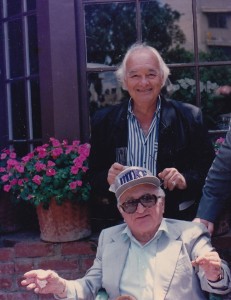 I don’t want to sound mean. Because I’m not. That said, I would sometimes ask my dad who this guy was or that guy. It would be a random dude that let’s say was always hanging around Jan Murray or Red Buttons. Sorry I’m not coming up with bigger names, but these were big names in my world. I guess I could say Frank. We’ll get back to Frank.
I don’t want to sound mean. Because I’m not. That said, I would sometimes ask my dad who this guy was or that guy. It would be a random dude that let’s say was always hanging around Jan Murray or Red Buttons. Sorry I’m not coming up with bigger names, but these were big names in my world. I guess I could say Frank. We’ll get back to Frank.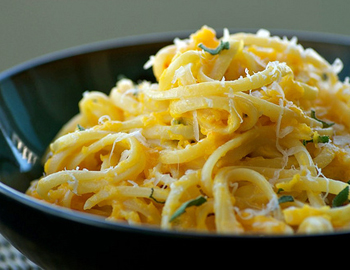 My dad is a competitive person, especially when it comes to the weather in wintertime. He'll call me from Rhode Island and say, "What's the weather like in San Diego?"
My dad is a competitive person, especially when it comes to the weather in wintertime. He'll call me from Rhode Island and say, "What's the weather like in San Diego?"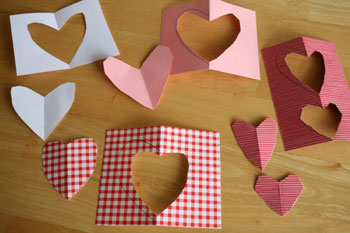 Two weeks before Thanksgiving, my five-year-old son began making paper hearts. He had discovered how to make a perfectly balanced heart by carefully folding the paper first. There seems to be a metaphor here, but for what I’m not certain: maybe for love, maybe for the way my son approaches every task, perhaps for both of these things. Years later, as an adult, he will design and make models of water treatment plants, bridges, glass windows that are a full story high; he will marry a woman who sometimes wears a hardhat as she performs bridge inspections.
Two weeks before Thanksgiving, my five-year-old son began making paper hearts. He had discovered how to make a perfectly balanced heart by carefully folding the paper first. There seems to be a metaphor here, but for what I’m not certain: maybe for love, maybe for the way my son approaches every task, perhaps for both of these things. Years later, as an adult, he will design and make models of water treatment plants, bridges, glass windows that are a full story high; he will marry a woman who sometimes wears a hardhat as she performs bridge inspections.